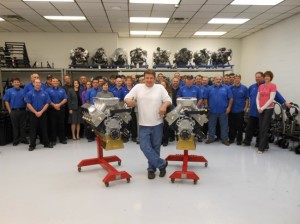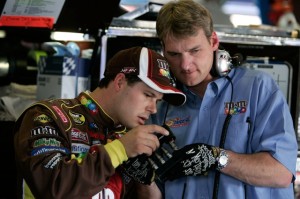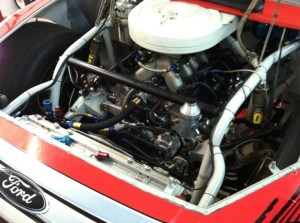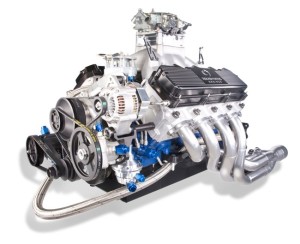 In December, Roush Yates Engines (RYE) celebrated its 10th Anniversary and will reset the compass into a new area of the business, but it’s all according to plan.
In December, Roush Yates Engines (RYE) celebrated its 10th Anniversary and will reset the compass into a new area of the business, but it’s all according to plan.
Engine builders who used to see RYE at local races as competitors, will now be able to work directly with them and their vast resources when building their own engines. We talked to Doug Yates about what’s ahead as well as what they’ve accomplished in just 10 years. “It’s a really neat story how we put the company together,” says RYE’s CEO Yates. “We found ourselves at a point where it made sense to come together. My dad and I had our teams, and Jack Roush had his teams, and we were really the last Ford guys – in fact, the only Ford guys – racing in Sprint Cup at the time. We had just built this beautiful facility here in Morrisville, NC, which was 75,000 square-feet, and we were looking down the road and saw Toyota coming and had some insight, or concerns, about how they were going to do their business. So we said to Jack that it makes a lot sense to do this together now.”
Merging two fierce rivals’ engine departments was not exactly the easiest thing to accomplish. The two organizations had spent many years trying to beat each other to be the top Ford team every week, but with Doug Yates, a well respected “engine man” at the helm, the company set its course for Daytona.
 Dodge was already in it at that point and they had raised the bar with their new engine. And seeing Toyota coming Yates says that he, his dad Robert and Jack all knew it was better to fight the opposition as one rather than separately.
Dodge was already in it at that point and they had raised the bar with their new engine. And seeing Toyota coming Yates says that he, his dad Robert and Jack all knew it was better to fight the opposition as one rather than separately.
“We were at Atlanta back when it was in the fall and we asked Jack for a meeting. We went to one of the motorhomes there and talked about it, and the very next week, we had a deal. We let everybody else in our organizations put the details together, but we were on our way. That was fall of 2003, and one of the proudest moment I have.”
Yates says that after the deal was put together the tough work began immediately. “A lot of ‘seven-days-a-week’ and ‘sleeping-at-the-shop’ type of days were ahead, but we sat on the front row for the Daytona 500 with Greg Biffle and Elliot Sadler with Jack’s car and my dad’s car,” he explains. “And one of the pictures in our lobby here, is that day and that moment. For two guys that really competed hard against each other, and some might even say didn’t like each other that much, to come together was pretty amazing.”
Formulating the FR9
Yates says that one of the proudest moments of his company’s 10-year span has been the development and introduction of a totally new NASCAR engine, the Ford FR9, which stands for Ford Racing 2009.
 “We didn’t introduce the FR9 until the fall of 2009, and didn’t start racing it until 2010,” says Yates, who used his NASCAR engine building expertise to design and build the new engine out of using plastic first before machining any metal until they had every part fit to the block.
“We didn’t introduce the FR9 until the fall of 2009, and didn’t start racing it until 2010,” says Yates, who used his NASCAR engine building expertise to design and build the new engine out of using plastic first before machining any metal until they had every part fit to the block.
“We have an SLA machine (3D printer) here in-house where we can make prototypes parts. And we printed the entire engine out of plastic to start with, and built it completely. And then as we started getting in castings, or machining parts, we’d bolt them on and replace the plastic with the actual parts. What made that so nice was when we went to assemble the engine for the first time, it went together just like any other engine that we built. The special part about that whole project was that we had never – and Ford had never – designed a clean sheet engine. So together we collaborated and made an engine that was purpose-built for NASCAR, and purpose-built for how we at Roush Yates like to build our engines.”
Yates says that he’s proud of all of the accomplishments his company has achieved, but the Daytona 500 races are always a really big deal for them. “To be able to win Daytona with Matt Kenseth in 2009 and Trevor Bayne in 2011 and Matt again in 2012 – to win three out of four Daytona 500s and to help the Wood Brothers get back to Victory Lane, which their history in the sport and with the Ford in particular, those are really proud moments.”
 According to Yates, they have a tradition at the shop after a race win. “The team that wins gives us their flag and we hang it up on the wall here. That’s what we do to celebrate our wins.”
Today, RYE is transitioning at its strategy for the grassroots market. They have successfully built a lot of the grassroots level race engines for the last few years but the plan has always been to learn it and move into manufacturing parts for the market.
According to Yates, they have a tradition at the shop after a race win. “The team that wins gives us their flag and we hang it up on the wall here. That’s what we do to celebrate our wins.”
Today, RYE is transitioning at its strategy for the grassroots market. They have successfully built a lot of the grassroots level race engines for the last few years but the plan has always been to learn it and move into manufacturing parts for the market.
“What we wanted to do when we entered the grassroots market – the Dirt Late Models, Off-Road Trucks and Sprint Cars – was several things,” Yates explains. “One, we had inventory that we needed to put to work and find homes for. And a lot of the take-offs and the platforms that we had developed with our NASCAR engines were a perfect fit for Dirt Late Model and Sprint Car in particular. We wanted to get into these markets and understand them better. And I’ll tell you what, it’s not like building a NASCAR engine, it’s totally different. We’ve gained a lot of knowledge and a lot of respect for the people in those series and it’s very specific to each one of the disciplines, and we’ve learned a lot. So what we’re doing now is instead of building engines for everybody across the country, we are transitioning into bringing our own products to market, and supporting the engine builders in those series. It was strategic in the fact that we had to learn the market, so we had to learn the products and the needs.
“We wanted to take our NASCAR engine technology to grassroots racers and engine builders across the country (and world), and we’re really excited about the next phase of our program.”
The latest creation from RYE was unveiled at the PRI Show in December. “I think its going to be something that is going to take the whole industry up a notch and take it to a whole new level while at the same time being considerate of pricing and the markets as they are in. And we’re excited about bringing out our first major product.” Yates says the plan is to eventually bring out more products to bolt onto the new engine block and also new platforms in the years to come. “We are not going to try to control everything,” says Yates. “We want different suppliers to build components for it and we want the block to be well received from all the other vendors in the industry. We want them to make parts for this engine as well. I think this collaboration with manufacturers and the other people in the industry that are out there making parts for grassroots racers is what we are excited about most. We want to be a good player and a good partner in the industry, and we feel like this is the right approach.”
Article courtesy of Engine Builder.













